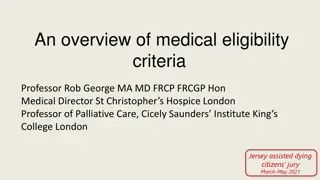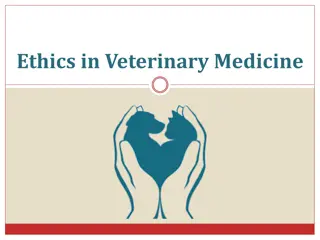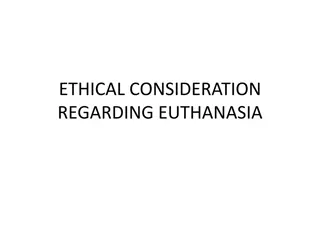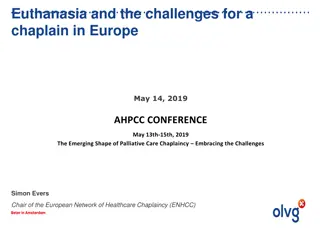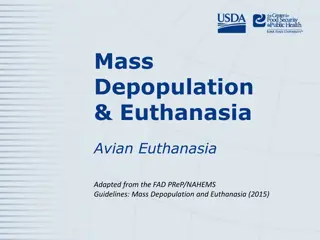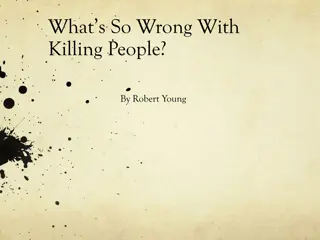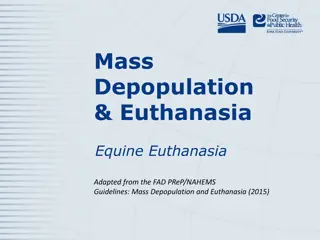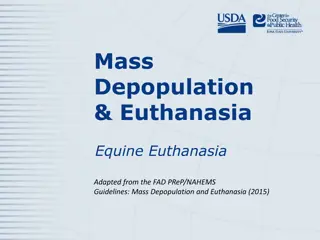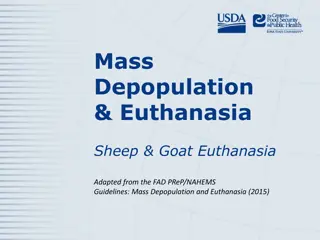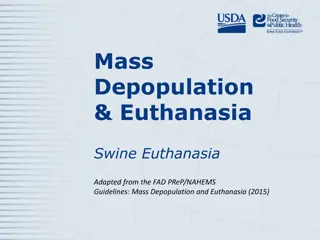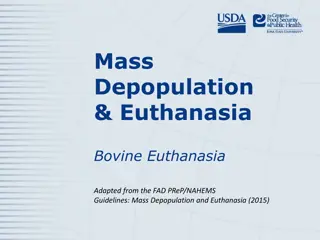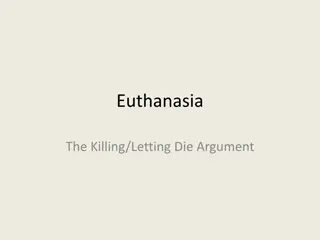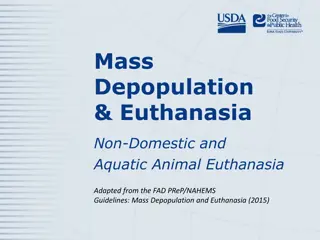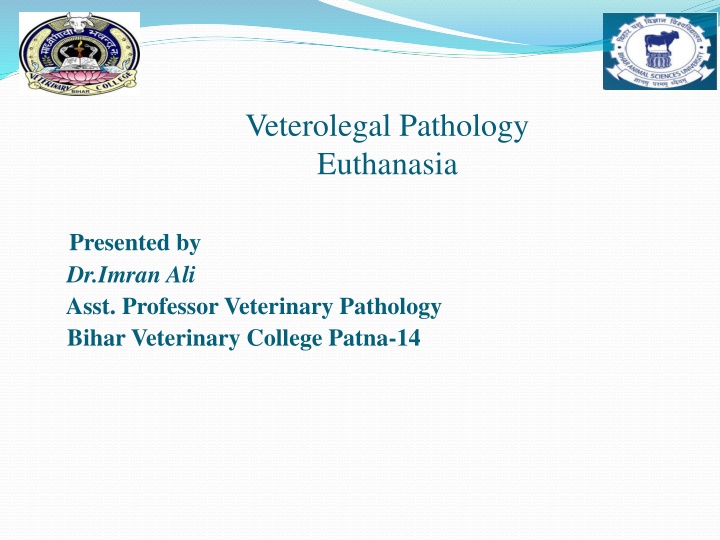
Euthanasia in Veterinary Pathology
Explore the concept of euthanasia in veterinary pathology, focusing on humane reasons for providing painless death to animals in hopeless cases. Learn about methods, advantages, disadvantages, and precautions associated with euthanasia in animals.
Download Presentation

Please find below an Image/Link to download the presentation.
The content on the website is provided AS IS for your information and personal use only. It may not be sold, licensed, or shared on other websites without obtaining consent from the author. If you encounter any issues during the download, it is possible that the publisher has removed the file from their server.
You are allowed to download the files provided on this website for personal or commercial use, subject to the condition that they are used lawfully. All files are the property of their respective owners.
The content on the website is provided AS IS for your information and personal use only. It may not be sold, licensed, or shared on other websites without obtaining consent from the author.
E N D
Presentation Transcript
Veterolegal Pathology Euthanasia Presented by Dr.Imran Ali Asst. Professor Veterinary Pathology Bihar Veterinary College Patna-14
EUTHANASIA Euthanasia is the production of quiet, painless death in an animal for humane reasons. Euthanasia is performed for the hopeless cases when treatment would be ineffective and the animal is suffering severe pain.
The selection of the method of euthanasia is dependent upon the species of the animal, available means of control of the animal, numbers of animals, economic considerations and the wishes of the owner. While selecting the method of euthanasia the following points should be kept in mind The method should produce death without pain. The time to produce unconsciousness and death should be short. The method should be reliable. The method should minimize undesirable psychological stress. The method should be compatible with its purposes. It should minimize the emotional effect upon observers and operators. It should be economically feasible. It should have a restricted environmental impact. It should be safe for the personnel involved. 1. 2. 3. 4. 5. 6. 7. 8. 9.
METHODS OF EUTHANASIA Inhalant Agents a) Inhalant Anaesthetics The inhalant anaesthetics, primarily chloroform, ether, nalothane and methoxyflurane, have been used for the euthanasia of pups and kittens. The animals are confined in a small, closed chamber into which cotton or gauze saturated with anaesthetics liquid is placed. The vapours are inhaled by the animal until death ensues. 1.
DISADVANTAGES The struggling and excitement caused by irritant vapours and the stimulation of central nervous system during the induction stage of anaesthesia are undesirable. Ether is flammable hence cannot be used near an open flame. Chronic exposure to chloroform or halothane or methoxyflurane is injurious to personnel. Both halothane and methoxyflurane are expensive. 1. 2. 3. 4.
CARBON MONOXIDE Inhalation of pure carbon monoxide (CO) causes rapid and painless death. It converts the hemoglobin to carboxyhaemoglobin and causes anoxia. Carbon monoxide can be effectively used for the euthanasia of small animals including dog and cats provided that proper equipment is available and adequate safety precautions are observed. There are three methods of carbon monoxide production: Chemical interaction of crystals of sodium format and sulphuric acid. Exhaust fumes from engines combusting petroleum. Use of cylinder gas. 1. 2. 3.
PRECAUTIONS Personnel using the gas must be thoroughly instructed in its use and und and understand the hazards and limitations. The lethal chamber must be equipped with internal lighting and view ports. The gas generation process should be adequate to achieve the desired CO concentration throughout the lethal chamber. 1. 2. 3.
CARBON DIOXIDE Carbon dioxide has been effectively used to euthanise small laboratory animals such as mice, rats, guinea pigs and rabbits. The combination of 40 per carbon dioxide and 3 per cent carbon monoxide is relatively cheap, noninflammable, nonexplosive, odourless and presents no hazard to the operator.
HYDROGEN CYANIDE GAS Hydrogen cyanide gas is produced by placing pellets of sodium cyanide in sulphuric acid. An airtight chamber required. It causes lethal histotoxic anoxia. The effect of the gas is rapid, reliable and irreversible. It cuases violent convulsive seizures and irritates the respiratory mucosa. It endangers the operator. It should not be used for euthanasia.
NON-INHALANT AGENTS A) Barbiturates: -Any of the Barbituric acid derivatives can be used in excessive dosage to produce euthanasia of individual dogs, cats, and other small animals. The barbiturates are generally given intravenously for the purpose of euthanasia. B) Chloral Hydrate: - Chloral hydrate is used for euthanasia in large animals. It fatally depresses the respiratory centers. It is not recommended for use in small animals because of its slow action and death is preceded by unpleasant manifestations such as crying, muscular spasms and gasping. C) Strychnine: - Strychnine in any form should not be used for euthanasia for any animal. It increases the excitability produces violent muscular contractions. The convulsion produces excruciating pain. D) Hydrocyanic Acid: - Hydrocyanic acid causes histotoxic and paralysis of the tissues enzyme system. Death appears to be painful. It produces muscular tetany and the animal cries loudly before becoming unconscious. Hydrocyanic acid is not recommended for euthanasia.
E) Magnesium Sulphate: - Magnesium sulphate can be used to produce euthanasia in both small and large animals. The magnesium ion depresses all parts of the central nervous system and unconsciousness occurs prior to fatal respiratory paralysis. F) Curariform Drugs: - The use of curariform drugs has been suggested for euthanasia. These drugs produce death by immobilising the respiratory muscles. There is no depressant action on brain. The use of these drugs to produce euthanasia is not recommended.
PHYSICAL METHODS A) Electrocution:- Electrocution as a form of euthanasia has been used for various species of animals. Originally, only the simplest apparatus was used. The usual procedure for electrical destruction of cats to pass on alternating current from the fore feet to hind feet for about one minute, with open-circuit voltage of 500 to 1000 volts. Experiments in dogs and in man have shown the necessity of directing the electrical current through the brain in order to produce unconsciousness. B) Shooting:- Accurate and careful shooting is the most humane and the most rapid method of euthanasia. Almost any gun that fires a projectile can be used. A shotgun is preferable to a riffle. The target point for the most species can be located by drawing imaginary lines from each ear to the opposite eye.
CONSENT FORM FOR EUTHANASIA Species . Breed .. .. I, the undersigned, do hereby certify that I am owner (duly authorised agent for the owner) of the above mentioned animal, that I do hereby given the veterinarians of the .. ( Name of the Veterinary Hospital) Sex . Colour . Age Identification Marks Place .. (Signature of the owner or authorized agent) Name . Address ___________________________________________________________________________ (To be filled-in by the Veterinary Doctor) Mode of euthanasia Mode of disposal of carcass . Date .. Signature of Doctor .. Seal Registration No. .
THE END The resources available on book chapter and used for the purpose of teaching students only.



